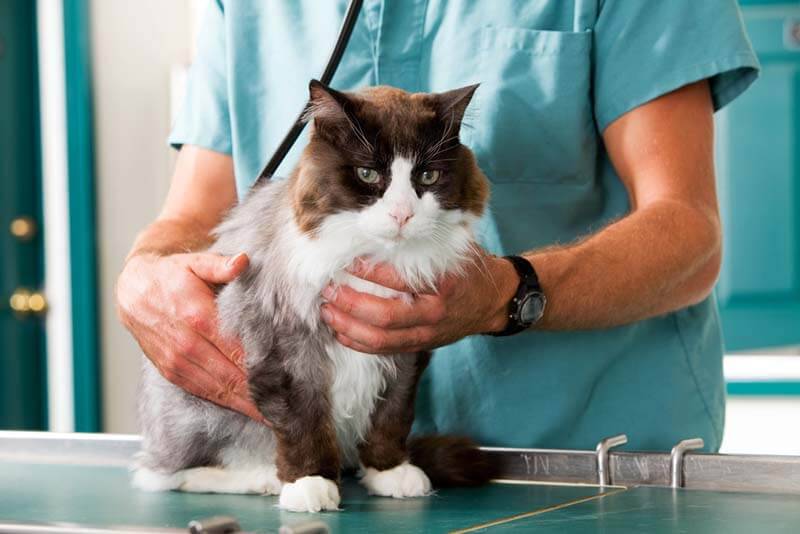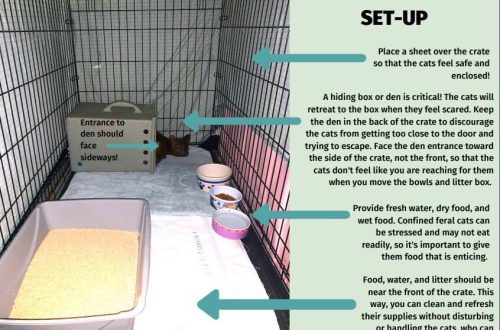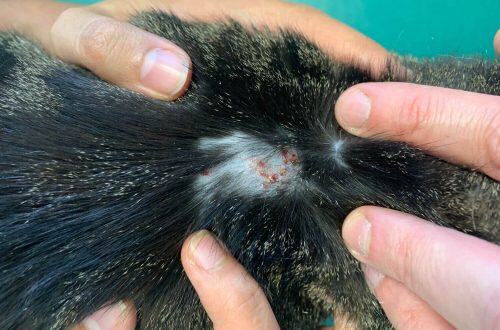
How to inject a cat intramuscularly?

Contents
- In what cases are injections given intramuscularly to a cat?
- Features of intramuscular injections
- Differences between subcutaneous and intravenous injections
- Where is the cat injected intramuscularly?
- Preparing for an injection
- How to give an injection to a cat intramuscularly – step by step instructions
- Possible complications
- Answers to frequently asked questions to veterinarians
In what cases are injections given intramuscularly to a cat?
Situations such as poisoning, pain syndrome, trauma, insect or snake bites, an acute allergic reaction require immediate help. Also, an intramuscular injection may be necessary for a cat in cases where it receives long-term treatment, or the animal has a chronic disease that requires regular administration of drugs.
Features of intramuscular injections
During intramuscular injection, the drug is delivered directly into the depth of muscle tissue.
Every medical procedure has certain disadvantages and advantages.
The obvious advantages include the following:
An intramuscular injection can be done independently by any person who does not have special medical or veterinary skills.
Slow, gradual intake of the drug makes it possible to dose the drug into the bloodstream and maintain a stable concentration of drugs in the animal’s body.
The disadvantages include pain when a large number of drugs are injected into the muscle, which have an irritating effect. Muscle tissues are well innervated due to the developed circulatory system, so an injection can be quite painful for a pet.

Differences between subcutaneous and intravenous injections
The most common methods of drug administration in veterinary practice are subcutaneous, intramuscular and intravenous techniques.
Subcutaneous injections differ from intramuscular injections in the depth of penetration of the needle into the tissues and the possible allowable volume of injected drugs and solutions. The withers area of a cat, unlike other places on the pet’s body, has the least pronounced soreness, since not many nerve endings are concentrated in it. And, unlike the tissues of the thigh muscles, the introduction of drugs into this area does not cause severe pain in the pet. A much larger volume of fluid can be injected subcutaneously than intramuscularly, since the subcutaneous tissue in animals is quite elastic and can accommodate relatively large amounts of drugs and solutions.
Intravenous injections should be performed only by veterinarians, as such a procedure requires professional skills and strict adherence to the rules and techniques of the procedure.

Where is the cat injected intramuscularly?
Next, we will consider in more detail how and where to inject an injection into a cat intramuscularly.
Drugs can be injected into strictly defined parts of the animal’s body.
For intramuscular injections, large thighs and shoulder muscles are suitable. For independent intramuscular injections, it is not recommended to use the shoulder area, since a lot of nerve endings are concentrated there, and the muscles are not large enough. It is recommended to administer drugs on their own only in the withers area – for subcutaneous injections, in the thigh muscles – for intramuscular injections.
Preparing for an injection
In order for the procedure to be as comfortable and quick as possible for you and your furry patient, it is important to prepare in advance.
Before the procedure, wash your hands thoroughly with soap and disinfect them with alcohol.
Calm down the cat, stroke it, give it a treat and prepare the place where you plan to give the injection. The surface on which the cat will be located during the procedure should be non-slippery, even, and most importantly, comfortable for you (you can use a table, cabinet or sofa).
Prepare everything you need for the injection: alcohol (or other disinfectant), a syringe with pre-filled medicine, cotton or cotton pads, fixatives, a soft blanket. Use sterile disposable syringes.
After calming and preparing the animal, you need to examine the skin in the injection area, there should be no irritation, redness and inflamed areas.
If long hair makes the procedure difficult, it can be sheared in the injection area.

How to choose a syringe and needle
The choice of a syringe for injection depends on the following factors: what kind of injection is planned – subcutaneous or intramuscular, how much of the drug needs to be injected, what age and size of the pet, what viscosity (viscosity) the drug has, what is the degree of pain when it is administered.
When choosing a syringe, proceed from the condition that the injection should be done as quickly as possible. To do this, pay attention to the consistency of the drug – if the liquid is thick, viscous, viscous, oily or has the properties of a suspension, the needle should be thicker. Such a solution can clog a thin needle, and the injection will last longer, which subsequently only increases the stress of the animal. Conversely, it is worth choosing a thinner needle for thin drugs – so the discomfort from the injection will be minimized.
Self-administered intramuscular injections to cats are most safely performed with insulin syringes or 2 ml syringes.
If the drug is non-painful, water-based, it is advisable to use a syringe with the thinnest possible needle. So, the injection will be the least painful and minimally injure the muscle tissue. For dosages of 1 ml or less, an insulin syringe with a short and thin needle can be used. Insulin syringes are the safest way to inject small kittens.

Preparation of the medicine
Before you start taking the medicine, it is important to carefully read the instructions for the drug and the doctor’s prescription. If you have any doubts or questions, be sure to contact your doctor. Or call your veterinary clinic to make sure the dosage and route of administration is correct before you give the injection.
Make sure that the method of administration of the drug corresponds to the manufacturer’s description. Medicines can be used for subcutaneous, intramuscular, intravenous injections, and it is important to know for sure that the drug can be administered in one way or another. Some drugs, if administered incorrectly, can cause tissue necrosis and abscess at the injection site.
If the instructions for the drug indicate only the intravenous route of administration, then such drugs should not be administered either subcutaneously or intramuscularly, even in the most minimal dosages.
Observe the dosage and markings on the syringe. Check the expiration date of the drug. Warm the drug drawn into the syringe in your hand if it was stored in the refrigerator.
If the drug is available in powder consistency, it is preliminarily diluted in a solvent that is attached to the drug, saline or novocaine. Ask your doctor about possible methods of dissolution, or follow the instructions for the drug.

If the drug is in a vial with a rubber cap, for the convenience of taking the drug, you can insert an additional needle to release air from the vial. This technique will help facilitate the collection of medication.
After the medicine is dialed, you need to free the syringe from air bubbles. Turn the syringe vertically, gently tap the contents of the syringe, lifting the air bubbles up, release a few drops of the drug into the air.
Draw the medicine into the syringe just before the injection. Remove the protective cap of the needle before injection, not before. Do not expose the needle without a protective cap to the air, as the needle may become contaminated with microflora, which is fraught with inflammation at the injection site.
How to fix a pet?
For a safe and quick injection procedure, it is important to securely, but at the same time gently and accurately, fix the animal. To properly fix the cat for the injection, you need to hold it very carefully. Remember not to hold your pet roughly or forcefully, as this can lead to physical injury and severe stress. You can not hold the cat by the withers, as this does not lead to a reliable fixation of the animal, but can lead to serious injuries – damage to the neck muscles and trachea, displacement of the vertebrae.
Special fixing bags can only be used if placing the cat in the bag does not cause a negative reaction in her.
To fix cats, it is recommended to use the method of soft swaddling or covering with a soft towel in the sphinx position. Such a gentle and non-intimidating approach reduces the risk of injury and makes it possible to give a series of injections in case of a long course of treatment.
Try not to cause additional stress to the cat during the procedure. If she is scared, don’t use force to hold her down. The cat will be even more frightened and will break out with great effort. Release the pet, let him calm down and understand that nothing terrible is happening, repeat the procedure. If the cat calmly reacts to manipulation, then do not use force, act confidently, but gently. During fixation, be careful not to hurt her.

During the procedure, it is very important to talk to the pet in a calm voice, calm him down, and after the procedure, treat him with a delicious treat.
Correct and secure fixation of the furry patient helps to reduce the risk of injury for both the cat and the person performing the procedure.
Now that everything is ready, you can proceed directly to the injection.
How to give an injection to a cat intramuscularly – step by step instructions
In order to correctly inject the cat into the thigh intramuscularly, the needle is injected into the muscle between the knee and hip joints. To the touch, this is the softest place in the triangle that the joints form (marked in green in the photo below).

So, how to make an intramuscular injection to a cat – step by step:
Pet and fix the pet yourself or with the help of an assistant. If the injection is performed with an assistant, then you can put the cat on its side so that the assistant can fix and hold the paws.
Find the softest place in the back of the thigh and relax the limb by lightly massaging the muscle, fix it.
Determine, by feeling with your fingers, where the bone is located in order not to touch it with the needle. Do not squeeze the cat’s muscle during the injection.
In order to avoid getting the needle into the sciatic nerve or joint, it is necessary with two fingers – thumb and forefinger, to fix the thigh muscles on both sides and insert the needle into the muscle in the area between the fingers.
Gently and quickly insert the needle into the middle of the cat’s thigh at about a 45-degree angle to a depth of about 1 cm.
Do not administer the medicine abruptly and too quickly, so as not to injure muscle tissue, skin and cause additional pain to the animal. The volume of the drug in 1 ml is injected for at least three seconds.
Gently, smoothly remove the needle at the same angle as it was inserted.
Do not administer large amounts of drugs to your cat at the same time. If necessary, then you need to make several injections in different places.
If a drop of blood comes out, gently press the injection site with an antiseptic cotton swab and hold for several minutes.
Praise and reassure your pet, treat him with a treat at the end of the procedure.
Intramuscular injection for a kitten
It is desirable that medical manipulations and procedures for babies are carried out by veterinary specialists, since the risks of injuring a small patient on their own are very high. If the situation requires urgent help, you will have to make an injection yourself.
In order to inject a kitten intramuscularly, it is necessary to take into account the peculiarities of the anatomical structure of small animals. The muscles and subcutaneous tissue of kittens are not yet sufficiently developed, the vessels and nerves are not protected by the volume of muscle tissue and are close enough to the surface of the body.
Therefore, it is important to use thin needles, control the depth of its insertion and prevent the needle from entering the bone area. For babies, insulin syringes and 1 ml syringes are the safest. If the medicine is not thick, a thin needle will allow the drug to be freely injected. Also, if it is necessary to inject a thick preparation, 2 ml syringes with a minimum diameter needle can be used.
It is important to take into account the fragility of the small patient and gently fix the kitten, without squeezing too much when holding it and without frightening it. After the procedure, calm the baby and treat him to something delicious. So, the injection will not seem scary to the little patient.

Possible complications
As a rule, injections do not cause negative consequences. But sometimes they can occur not only with an inexperienced owner, but also with a specialist. Knowing about possible complications is important in order to provide the pet with the necessary assistance in time.
If you inject the cat incorrectly, for example, inject the drug in the wrong place, damage the vessel or get into the nerve, the problems may be as follows:
If at the injection site after removing the needle drops of blood came out, this indicates damage to the wall of the blood vessel. If a few drops of blood have been released, then to stop the bleeding, it is enough to apply cold for 10-15 minutes to the injection site (ice or a frozen product from the freezer wrapped in a clean cloth or a damp cold towel).
Infiltration or induration (bump, swelling) at the injection site indicates that the injected drug is not absorbed into the bloodstream, or an inflammatory process has begun in the injured tissue or in the surrounding tissues. The causes of infiltration can be: the introduction of too large a volume of the drug at once, the infection with it, the very rapid administration of the drug, the allergic reaction of tissues, the use of drugs without first warming up to body temperature. What to do in such a situation? If the infiltrate does not resolve, does not go away for a long time, the place of compaction becomes hot, painful, increases in size, the animal feels worse, it is necessary to show the cat to the veterinarian.
Long-term non-absorbable infiltrates and seals can lead to abscesses. A purulent inflammation is formed in the infiltrate cavity or at the site of compaction, the injection site may swell, become hot and painful. The cat may refuse to eat, become lethargic, apathetic, body temperature rises. This condition is dangerous and in severe cases can lead to sepsis and death of the animal. It is important to seek surgical help as soon as possible.
Lameness after injection. There can be several reasons for lameness. One of them is muscle damage due to the use of tissue irritating solutions, antibiotics and thick, difficult to absorb drugs, leading to severe pain at the injection site. Lameness can occur due to an unsuccessful injection, or as a result of a needle entering a nerve. As a rule, lameness disappears within an hour after the injection. If the lameness gets worse, does not go away within a few days, the limb has lost mobility and does not straighten, and the cat does not lean on it when walking, it is necessary to show the pet to the doctor.
Temperature increase. Such a reaction of the body can be caused by an allergy to the injected drug, or serve as a symptom of an inflammatory process at the injection site. This can happen if sterility was not observed during the procedure.
severe reaction to stress. Cats are very sensitive animals. They have a hard time with long-term chronic stress, pain and discomfort. If the pet tolerates injections too hard, hides after the procedures, becomes shy and nervous, refuses to eat, does not allow himself to be touched, hides in secluded places and does not leave them for a long time, then, in agreement with the attending physician, it is advisable to move as soon as possible to other forms of drug administration. For example, tablets or suspensions. To reduce stress levels, you can use special soothing synthetic facial cat pheromones in the form of a diffuser.
Pay close attention to how your pet feels and changes in behavior. In case of refusal to eat, lethargy, fever, soreness at the injection site, or the appearance of bloody or purulent discharge at the injection site, immediately show the pet to a veterinary specialist.
The following video shows how to properly inject a cat intramuscularly.
Answers to frequently asked questions to veterinarians
December 21 2021
Updated: December 22, 2021





